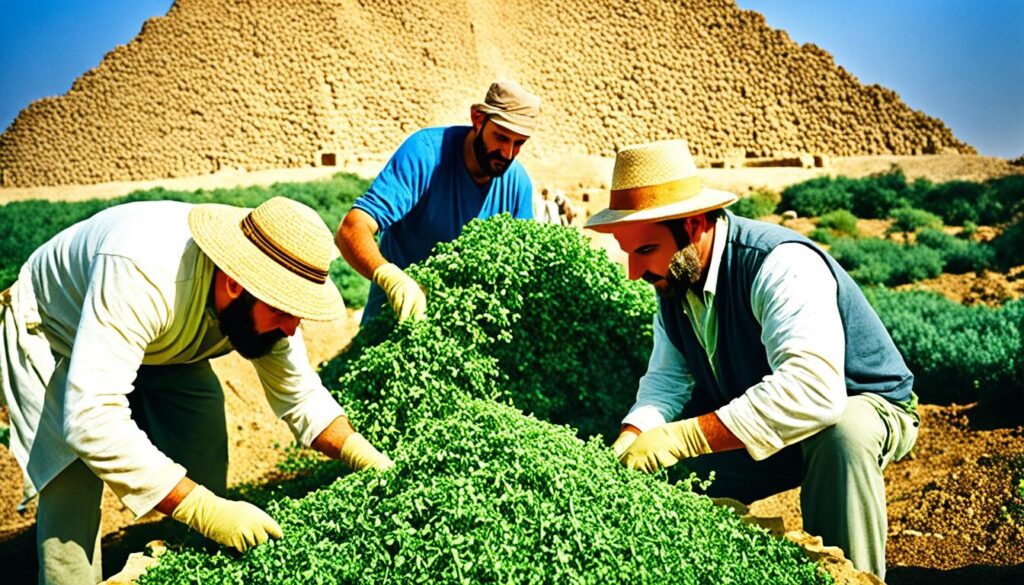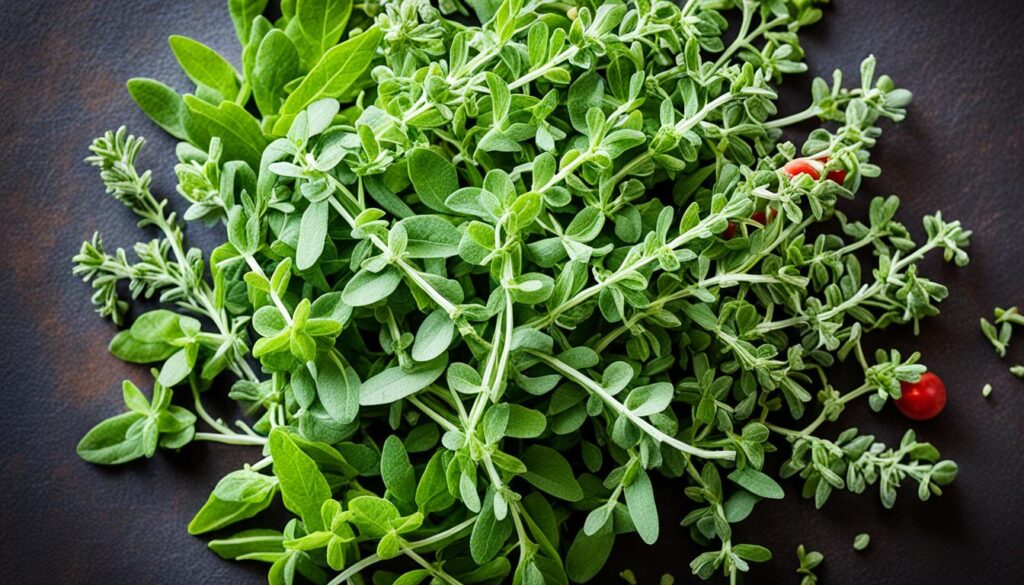Welcome to the world of marjoram, a key herb with a unique taste and many health perks. It makes your meals taste better and is good for you. You’ll find out how marjoram is used in cooking, how to grow it, and how to use it in your daily meals.
What is Marjoram?
https://www.youtube.com/watch?v=NYh47KkweSA
Marjoram is a type of Origanum majorana, a perennial herb in the mint family. It comes from the Mediterranean and is loved for its sweet taste. This herb is great in many dishes, making it a key ingredient in kitchens everywhere.
Marjoram is often used in cooking, available fresh or dried. Fresh marjoram tastes bright, while dried marjoram has a stronger flavor. It’s a favorite in European and Middle Eastern cooking, adding flavor to many dishes.
Some key things about marjoram include:
- Natively found in Mediterranean regions
- Aromatic, sweet, and slightly peppery flavor
- Used in both fresh and dried forms
- Essential in various culinary traditions
When you’re cooking, think about adding marjoram to your recipes. It’s great at making flavors pop. This herb is a must-have in any kitchen because it works so well with other foods.
Historical Significance of Marjoram

Marjoram was highly valued in ancient Greece and Rome for its smell and taste. It was more than just a spice in cooking. It was a symbol of joy and love, used in weddings and celebrations. This shows its deep cultural significance over time.
Old texts talk about its healing powers. Healers used it to treat many health issues. As trade grew, marjoram spread to new places, taking on new meanings. This shows how it has always been versatile and loved.
Looking into Marjoram’s history shows its big impact on food and culture. To connect with your food heritage, learn more about the historical uses of Marjoram. See how it can inspire your cooking today.
Marjoram Uses in Cooking
Marjoram is a key herb in cooking, adding flavor to many dishes. It’s used in many cuisines because of its unique taste. Whether fresh or dried, marjoram makes food more enjoyable.
Culinary Applications
Marjoram is not just for seasoning. Add it to sauces, soups, and marinades for extra flavor. For potato salads, mix in 1/4 cup of chopped marjoram for a boost of taste.
For hot potatoes, use 1/2 to 1 cup of dressing per 2 pounds. This helps the flavors soak in well.
In Italian cooking, marjoram is a must-have. It goes well with pasta, roasted veggies, and chicken. Chefs and home cooks love it for its versatility.
Flavor Profiles and Pairings
Marjoram tastes sweet, a bit bitter, and floral. It pairs well with thyme, sage, oregano, and basil. This makes it great for adding depth to dishes without overpowering them.
Try it in a Rainbow Potato Salad for color and flavor. Mix it with coarse mustard and chile-lime-salt for a zesty taste. Here are some marjoram pairing ideas:
| Herb | Flavor Characteristics |
|---|---|
| Thyme | Earthy, slightly minty |
| Sage | Warm, savory |
| Oregano | Pungent, spicy undertone |
| Basil | Refreshing, peppery |
Health Benefits of Marjoram

Marjoram is known for its great taste. But it’s also packed with health benefits. It’s low in calories but full of important nutrients. This makes it a great choice for your meals.
Nutritional Value
Fresh marjoram is full of vitamins and minerals. It has:
- Vitamins: High in vitamins A and C
- Minerals: Contains calcium and magnesium
- Fiber: Supports digestive health
- Antioxidants: May reduce inflammation
Medicinal Properties
Marjoram has been used for health for a long time. It offers many benefits:
- Digestive support: Can ease stomach issues
- Antimicrobial effects: Keeps away bad bacteria
- Respiratory aid: Helps with breathing problems
- Stress relief: Its scent can make you feel calm
Adding marjoram to your life is a smart move. It’s great for cooking and for your health. Enjoy its taste and its health perks.
| Nutrient | Amount per 1 tbsp | Health Benefit |
|---|---|---|
| Vitamins A | 132 IU | Supports eye health |
| Vitamins C | 1.7 mg | Boosts the immune system |
| Calcium | 40 mg | Essential for bone health |
| Magnesium | 15 mg | Supports muscle function |
| Fiber | 1 g | Aids in digestive health |
Growing and Harvesting Marjoram

Growing Marjoram (Origanum majorana) is fun for herb lovers. It comes from the Mediterranean and Turkey. This plant loves full sun and warm places. Start by picking a sunny spot with soil that’s a bit alkaline or neutral.
Make sure the soil drains well to prevent root rot. Marjoram doesn’t like wet feet.
Plant marjoram in a spot that’s a bit protected. It’s great because it can handle drought once it’s grown. Cutting it back often helps it grow bushy and stay healthy.
Harvesting marjoram at the right time is key. Cut it just before it blooms, on a sunny morning. This way, the leaves will be full of flavor. Cutting stems when they’re 6 to 8 inches tall keeps the taste good.
You can grow marjoram from seeds, cuttings, or layering. It’s easy to spread your herb garden. Marjoram is a must-have in Mediterranean cooking. It makes many dishes taste better, from meats to pasta. Growing marjoram is a great choice.
Marjoram as an Aromatic Herb
Marjoram (Origanum majorana) is a famous aromatic herb known for its sweet smell and taste. It comes from the Mediterranean and Turkey. This plant is part of the mint family and tastes sweeter than oregano. It’s often used fresh in cooking.
Marjoram is not just for cooking. Its essential oil is used in aromatherapy for its calming effects. The scent of marjoram makes food taste better and helps create a peaceful home atmosphere.
To grow marjoram, make sure it gets lots of sunlight and drains well. You can start it from seeds, cuttings, or divide mature plants in fall or spring. Keep an eye out for pests and diseases. Good places to buy marjoram include Jekka’s Herbs and Norfolk Herbs.
Marjoram is mostly used in cooking, but adding it to meals can also boost their health benefits. Using aromatic herbs like marjoram can make food taste better and be healthier. But, be careful if you have pets because marjoram is toxic to them.
| Characteristic | Detail |
|---|---|
| Family | Lamiaceae (Mint family) |
| Origin | Mediterranean region and Turkey |
| Flavor Profile | Delicate and sweeter than oregano |
| Growth Habit | Bushy mounds, about 60cm tall |
| Growing Conditions | Full sun, drought tolerant |
| Propagation Methods | Seeds, stem cuttings, division |
| Availability | Specialist herb nurseries recommended |
| Toxicity | Toxic to pets |
Substituting Marjoram in Recipes
If you need to replace Marjoram in your favorite dish, you have good options. Oregano is a great choice, with a similar strong taste. Thyme adds a unique flavor but works well in many dishes. Parsley brings a fresh taste, perfect for lighter recipes.
Here are some tips for herb substitutions:
| Herb | Flavor Profile | Usage Tips |
|---|---|---|
| Oregano | Earthy and robust | Use in equal amounts, as it has a stronger taste. |
| Thyme | Herbaceous and floral | Start with half the amount; adjust to taste. |
| Parsley | Fresh and slightly peppery | Use in larger amounts to maintain brightness. |
Remember, flavors can change a lot when you substitute herbs. Try to keep your dishes balanced. This is key for a dairy-free tomato tart, which uses fresh ingredients. For a tasty recipe, look at this tomato tart recipe.
Try different herb substitutions to find new flavors. Having a variety of herbs, like banana face ginger, can make your cooking better. For more on this herb, check out the guide on Panda Face Ginger.
How to Store Fresh Marjoram
Storing Marjoram right keeps its taste and smell fresh for a long time. The best way to keep it fresh is by putting it in the fridge. Wrap the marjoram in a damp paper towel and put it in a resealable bag. This keeps it moist, stops it from wilting, and keeps it fresh.
You can also trim the stems and put them in a glass of water. Cover the leaves with a plastic bag. This makes it feel like the plant is growing again, and it lasts longer.
Dried marjoram needs special care too. Keep it in an airtight container in a cool, dark place. This keeps it away from light and moisture. It helps the dried herb stay strong and tasty.
For tips on making tasty potato salads that go well with marjoram, check this resource.
Marjoram Recipe Tips for Home Cooks
Exploring marjoram can be fun, but knowing how to use it is key. Using fresh or dried marjoram is a big decision. Fresh marjoram adds a bright flavor and should be added last to keep its taste.
Dried marjoram, on the other hand, goes in early to blend with other flavors. This makes its taste richer.
Using Fresh vs. Dried Marjoram
Marjoram is great in dressings and dips too. It can make your salads and dips taste amazing. For example, mix it with fresh garlic and white balsamic vinaigrette for a tasty dressing.
This dressing is best eaten within three days. Adding unfiltered raw honey can give it a special flavor that goes well with marjoram.
Incorporating Marjoram in Dressings and Dips
Marjoram also works well in dips. Mix it with yogurt, cream cheese, or olive oil for tasty dips. It adds a unique taste that makes appetizers better.
Whether you use fresh or dried marjoram, it makes your food special. It adds a sophisticated touch that everyone will love.



